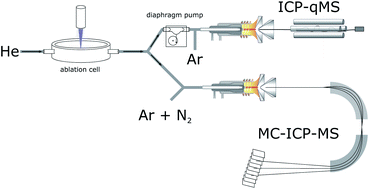Laser ablation split stream for in situ sulfur isotope and elemental analysis†
Abstract
In situ sulfur (S) isotope ratios and trace element chemistry were simultaneously determined in a wide selection of different (natural) sulfides and sulfates using femtosecond laser ablation split stream (fsLASS) inductively coupled plasma mass spectrometry (ICP-MS). The laser aerosol is split between a sequential quadrupole ICP-MS for trace element quantification and a multi-collector ICP-MS (MC-ICP-MS) for stable sulfur isotope ratio measurements. This LASS method is able to simultaneously determine S isotope ratios and element chemistry without a compromise in the measurement precision and measurement accuracy of the S isotope ratios. The quantification of major and trace elements in sulfide minerals down to the μg g−1 level was achieved. LASS shows overall lower sensitivity and higher limits of detection in comparison to direct trace element determination using LA-ICP-MS only, due to the lower amounts of sample introduced into the ICP-qMS. This compromise is acceptable given the additional information gained from obtaining simultaneously both the isotopic and elemental compositions.



 Please wait while we load your content...
Please wait while we load your content...